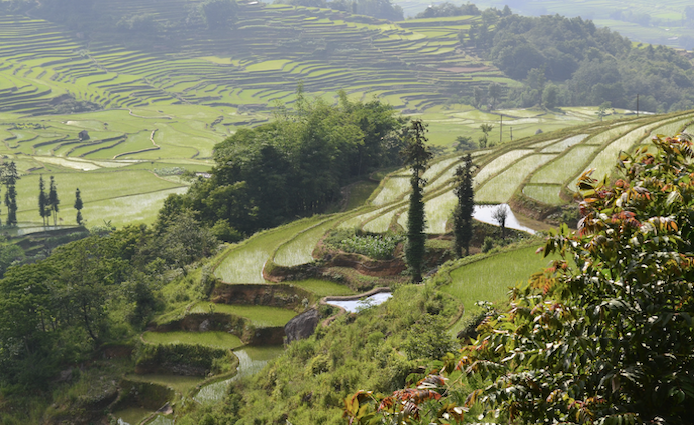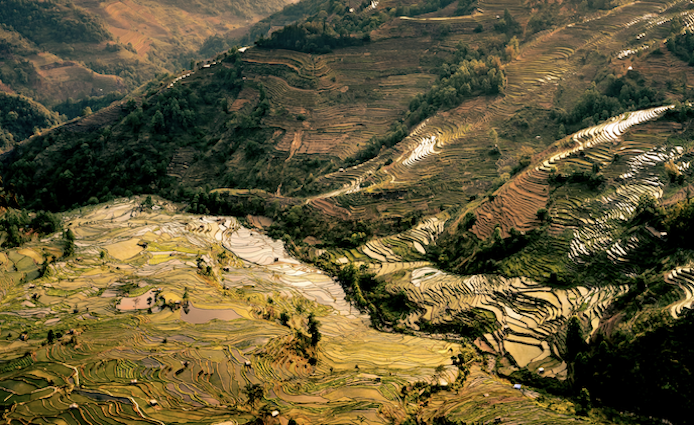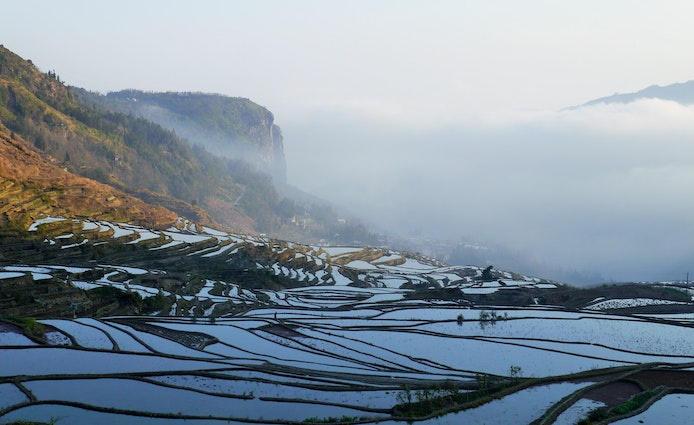
Biodiversity in the Hani Cultural Landscape 2
Diverse ecological zones
The mountaintop, where the climate is wet and cold, consists of forests, grassland and ponds and provides a variety of goods and services, such as wood, wild food plants and game, herbal medicine, fodder, fish cultures and watersheds. In this zone, tea gardens are also distributed and cardamom is cultivated as an understory crop.
Below this forest zone, where the climate is mild, villages have been built at an elevation of 1,800-1,900 meters. Below the village (middle mountain) zone sits the warmer agricultural zone. Here, at an elevation of 800 to 1,800 meters, extensive rice terraces are distributed across the low mountain slope and dry fields are kept for production of maize, wheat, potato, beans, buckwheat and vegetables. In addition, numerous patches of natural and artificial forests for production of wood and conservation of water and soil are scattered in this agriculture zone.

The hot valley is mainly inhabited by the Dai people who practice intensive rice cultivation, with two to three crops a year, and often have rice surpluses. Taking advantage of each other's strengths, the Dai people have a tradition of exchanging rice for firewood with the Hani people. The Hani and the Dai also share buffalo and spread the burden of buffalo husbandry between them.
Forests, the lifeblood of water. Another Hani proverb says that “Forests are the lifeblood of water; water is the lifeblood of rice terraces, and rice terraces are the lifeblood of the Hani people”. This bit of indigenous wisdom is perhaps the key to their complex forestry and land management system.Extensive natural forests are protected on the mountaintop in order to conserve water. Forests intercept rainfall and enhance the ability of soil to store water and allow groundwater to be recharged during the wet season. With little rainfall over the dry season, the forests help harvest dew from the heavy fog. In addition, the forests along streams and rivers are preserved and planted, and many tree areas are preserved in the rice terraces.

The Hani protect and plant trees around their villages through scenic forests that separate human space from “ghost” space, and protect villagers from strong winds and landslides. In contrast, other forests in the Ailao Mountains contain hundreds of edible plants (like wild mushrooms, vegetables, nuts, fruits) and insects, and medicinal plants, which are important to local livelihoods.

Finally, forests are not only essential to rice cultivation, but also to the Hani people's spiritual well-being. The Hani believe that their village deity lives in the forests. Every village has or shares a patch of natural forest under strict protection for the village deity. The ritual for worshipping the village deity is held annually in order to educate younger generations about how to care for the forests.
Reference: Our World-by Luohui Liang under CC BY-NC-SA 3.0
Photo Resource: Unsplash
If there's any copyright issue involved, please contact us to delete.



